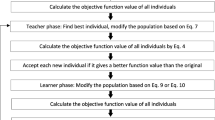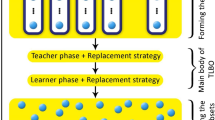Abstract
This paper presents a new optimization algorithm called fuzzy adaptive teaching–learning-based optimization (FATLBO) for solving numerical structural problems. This new algorithm introduces three new mechanisms for increasing the searching capability of teaching–learning-based optimization namely status monitor, fuzzy adaptive teaching–learning strategies, and remedial operator. The performance of FATLBO is compared with well-known optimization methods on 26 unconstrained mathematical problems and five structural engineering design problems. Based on the obtained results, it can be concluded that FATLBO is able to deliver excellence and competitive performance in solving various structural optimization problems.











Similar content being viewed by others
References
Lee KS, Geem ZW (2004) A new structural optimization method based on the harmony search algorithm. Comput Struct 82(9–10):781–798. doi:10.1016/j.compstruc.2004.01.002
Holland JH (1975) Adaptation in natural and artificial systems. University of Michigan Press. Ann Arbor, MI
Kennedy J, Eberhart R (1995) Particle swarm optimization. In: Paper presented at the proceedings of the IEEE international conference on neural networks, Perth, Australia
Storn R, Price K (1997) Differential evolution—a simple and efficient heuristic for global optimization over continuous spaces. J Global Optim 11(4):341–359
Cheng M-Y, Prayogo D (2014) Symbiotic organisms search: a new metaheuristic optimization algorithm. Comput Struct 139:98–112. doi:10.1016/j.compstruc.2014.03.007
Tran D-H, Cheng M-Y, Prayogo D (2016) A novel multiple objective symbiotic organisms search (MOSOS) for time–cost–labor utilization tradeoff problem. Knowl Based Syst 94:132–145. doi:10.1016/j.knosys.2015.11.016
Mirjalili S, Mirjalili SM, Hatamlou A (2015) Multi-verse optimizer: a nature-inspired algorithm for global optimization. Neural Comput Appl 27(2):495–513. doi:10.1007/s00521-015-1870-7
Rao RV (2016) Jaya: a simple and new optimization algorithm for solving constrained and unconstrained optimization problems. Int J Ind Eng Comput 7(1):19–34. doi:10.5267/j.ijiec.2015.8.004
Rao RV, Savsani VJ, Vakharia DP (2012) Teaching–learning-based optimization: an optimization method for continuous non-linear large scale problems. Inform Sci 183(1):1–15. doi:10.1016/j.ins.2011.08.006
Rao RV, Savsani VJ, Vakharia DP (2011) Teaching–learning-based optimization: a novel method for constrained mechanical design optimization problems. Comput Aided Des 43(3):303–315. doi:10.1016/j.cad.2010.12.015
Satapathy S, Naik A (2011) Data clustering based on teaching–learning-based optimization. In: Panigrahi B, Suganthan P, Das S, Satapathy S (eds) Swarm, evolutionary, and memetic computing, vol 7077. Lecture Notes in Computer Science. Springer Berlin Heidelberg, pp 148–156. doi:10.1007/978-3-642-27242-4_18
Naik A, Satapathy SC, Parvathi K (2012) Improvement of initial cluster center of C-means using teaching learning based optimization. Proc Technol 6:428–435. doi:10.1016/j.protcy.2012.10.051
Rao RV, Patel V (2013) Multi-objective optimization of two stage thermoelectric cooler using a modified teaching–learning-based optimization algorithm. Eng Appl Artif Intell 26(1):430–445. doi:10.1016/j.engappai.2012.02.016
Rao RV, Kalyankar VD (2013) Parameter optimization of modern machining processes using teaching–learning-based optimization algorithm. Eng Appl Artif Intell 26(1):524–531. doi:10.1016/j.engappai.2012.06.007
Rao RV, Patel V (2013) Multi-objective optimization of heat exchangers using a modified teaching–learning-based optimization algorithm. Appl Math Model 37(3):1147–1162. doi:10.1016/j.apm.2012.03.043
Rao RV, Patel V (2011) Multi-objective optimization of combined Brayton and inverse Brayton cycles using advanced optimization algorithms. Eng Optim 44(8):965–983. doi:10.1080/0305215x.2011.624183
Niknam T, Kavousi Fard A, Baziar A (2012) Multi-objective stochastic distribution feeder reconfiguration problem considering hydrogen and thermal energy production by fuel cell power plants. Energy 42(1):563–573. doi:10.1016/j.energy.2012.02.023
Niknam T, Azizipanah-Abarghooee R, Aghaei J (2013) A new modified teaching-learning algorithm for reserve constrained dynamic economic dispatch. IEEE Trans Power Syst 28(2):749–763. doi:10.1109/TPWRS.2012.2208273
Niknam T, Azizipanah-Abarghooee R, Rasoul Narimani M (2012) A new multi objective optimization approach based on TLBO for location of automatic voltage regulators in distribution systems. Eng Appl Artif Intell 25(8):1577–1588. doi:10.1016/j.engappai.2012.07.004
Toğan V (2012) Design of planar steel frames using teaching-learning based optimization. Eng Struct 34:225–232. doi:10.1016/j.engstruct.2011.08.035
Degertekin SO, Hayalioglu MS (2013) Sizing truss structures using teaching–learning-based optimization. Comput Struct. doi:10.1016/j.compstruc.2012.12.011
Rao RV (2016) Review of applications of TLBO algorithm and a tutorial for beginners to solve the unconstrained and constrained optimization problems. Decis Sci Lett 5(1):1–30. doi:10.5267/j.dsl.2015.9.003
Rao RV (2016) Teaching learning based optimization algorithm and its engineering applications. Springer International Publishing, Switzerland. doi:10.1007/978-3-319-22732-0
Rao RV, Patel V (2012) An elitist teaching–learning-based optimization algorithm for solving complex constrained optimization problems. Int J Ind Eng Comput 3(4):535–560
Rao RV, Patel V (2013) Comparative performance of an elitist teaching-learning-based optimization algorithm for solving unconstrained optimization problems. Int J Ind Eng Comput 4(1):29–50
Cheng M-Y, Lien L-C (2012) Hybrid artificial intelligence-based PBA for benchmark functions and facility layout design optimization. J Comput Civil Eng 26(5):612–624. doi:10.1061/(ASCE)CP.1943-5487.0000163
Deb K (2000) An efficient constraint handling method for genetic algorithms. Comput Meth Appl Mech Eng 186(2–4):311–338. doi:10.1016/S0045-7825(99)00389-8
Chickermane H, Gea HC (1996) Structural optimization using a new local approximation method. Int J Numer Meth Eng 39(5):829–846. doi:10.1002/(sici)1097-0207(19960315)39:5<829:aid-nme884>3.0.co;2-u
Gandomi AH, Yang X-S, Alavi AH (2011) Cuckoo search algorithm: a metaheuristic approach to solve structural optimization problems. Eng Comput. doi:10.1007/s00366-011-0241-y
Rao SS (1996) Engineering optimization: theory and practice, 3rd edn. Wiley, Chichester
Hsu Y-L, Liu T-C (2007) Developing a fuzzy proportional-derivative controller optimization engine for engineering design optimization problems. Eng Optim 39(6):679–700. doi:10.1080/03052150701252664
Ray T, Saini P (2001) Engineering design optimization using a swarm with an intelligent information sharing among individuals. Eng Optim 33(6):735–748. doi:10.1080/03052150108940941
Tsai J-F (2005) Global optimization of nonlinear fractional programming problems in engineering design. Eng Optim 37(4):399–409. doi:10.1080/03052150500066737
Amir H, Hasegawa T (1989) Nonlinear mixed-discrete structural optimization. J Struct Eng ASCE 115(3):626–646. doi:10.1061/(asce)0733-9445(1989)115:3(626)
Liebman JS, Chanaratna V, Khachaturian N (1981) Discrete structural optimization. J Struct Div ASCE 107(11):2177–2197
Shih CJ, Yang YC (2002) Generalized Hopfield network based structural optimization using sequential unconstrained minimization technique with additional penalty strategy. Adv Eng Software 33(7–10):721–729
Yun YS (2005) Study on adaptive hybrid genetic algorithm and its applications to engineering design problems. MSc Thesis, Waseda University
Gandomi AH, Yang X-S, Alavi AH (2011) Mixed variable structural optimization using firefly algorithm. Comput Struct 89(23–24):2325–2336. doi:10.1016/j.compstruc.2011.08.002
Gold S, Krishnamurty S (1997) Trade-offs in robust engineering design. In: Paper presented at the proceeding of the 1997 ASME design engineering technical conferences, Sacramento
Wang G (2003) Adaptive response surface method using inherited latin hypercube design points. J Mech Des 125(2):210–220. doi:10.1115/1.1561044
Author information
Authors and Affiliations
Corresponding author
Rights and permissions
About this article
Cite this article
Cheng, MY., Prayogo, D. A novel fuzzy adaptive teaching–learning-based optimization (FATLBO) for solving structural optimization problems. Engineering with Computers 33, 55–69 (2017). https://doi.org/10.1007/s00366-016-0456-z
Received:
Accepted:
Published:
Issue Date:
DOI: https://doi.org/10.1007/s00366-016-0456-z




